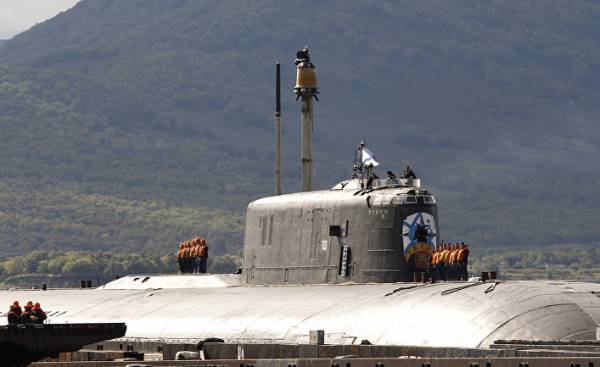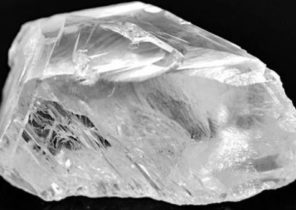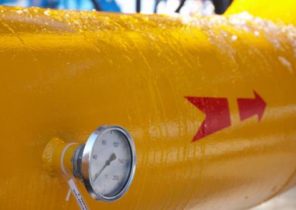
Submarine of project 949 — a very large, allowing it to carry on Board the heavy weapons. The length of the main batch and a half football fields (154 meters) and surface displacement 12 500 tonnes. Thus, this boat is in size the fourth largest in the world. Despite these dimensions, submarines of this project are able to develop a great maximum speed under water of 32 knots, and the depth of immersion of up to 500 meters. However, this boat got the impression that it sinks very slowly and does not have great maneuverability.
The main purpose of the boat 949-year project is the launch of 24 huge missiles P-700 “Granit”, which received the NATO code name SS-N-19 Shipwreck (“Shipwreck”). This cruise missile has a length of 10 meters and weighs nearly eight tons. The missile can be done from under the water on ground targets, located at a distance of over 600 kilometers. A rocket is launched from a launch tube with a block of solid rocket boosters, after which it sets in motion a turbojet engine, giving the “Granite” cruising speed of M=2.5, and which can vary depending on altitude. The guided missile by using a satellite system, with which the submarine can communicate by means of antenna. If the launch of the “Granite” is produced in one gulp, missiles can be summarized into a single network so they can transmit data to each other of targeting and approaching the goal from different angles. These missiles can also be equipped with nuclear warheads with a capacity of 500 kilotons.
Huge Russian submarines of project 949A “Antey” was designed during the cold war and had a very specific purpose: to hunt the American carriers, which are the pride of the U.S. Navy and the Foundation of their Maritime power.
Since each U.S. aircraft carrier protected by a small fleet of escort ships, and many of them are designed for anti-submarine warfare, “anteia” do not sneak up close for the implementation of the torpedo attack. Instead, they launch powerful anti-ship missiles, being at the distance of a few hundred kilometers from the target.
Missile submarines with cruise missiles is not a new concept. The first submarines with missiles on Board appeared in the 1950s, and created them on the basis of conventional submarines. The first Soviet submarines of project 675 with cruise missiles as the primary weapons entered the fleet in 1961.
In the mid-1970s, work began to build a large boat, third generation cruise missiles, which was called “Granite” (project 949). She had a double hull, standard for large Soviet submarines. The main body of the boat with compartments for the crew and with the ship’s systems were inside the external case of thin steel. On the “Ante” that have not yet been decommissioned, the distance of the outer hull from the inner is in different parts from five to 180 centimeters. Two nuclear reactors produce for this huge submarine 73 megawatts of electricity. The crew of more than 100 people takes nine or ten compartments that can be isolated from each other.
Submarine of project 949 — a very large, allowing it to carry on Board the heavy weapons. The length of the main batch and a half football fields (154 meters) and surface displacement 12 500 tonnes. Thus, this boat is in size the fourth largest in the world. Despite these dimensions, submarines of this project are able to develop a great maximum speed under water of 32 knots, and the depth of immersion of up to 500 meters. However, this boat got the impression that it sinks slowly and does not have great maneuverability.
The main purpose of the boat 949-year project is the launch of 24 huge missiles P-700 “Granit”, which received the NATO code name SS-N-19 Shipwreck (“Shipwreck”). This cruise missile has a length of 10 meters and weighs nearly eight tons. The missile can be done from under the water on ground targets, located at a distance of over 600 kilometers. A rocket is launched from a launch tube with a block of solid rocket boosters, after which it sets in motion a turbojet engine, giving the “Granite” cruising speed of M=2.5, and which can vary depending on altitude. The guided missile by using a satellite system, with which the submarine can communicate by means of antenna. If the launch of the “Granite” is produced in one gulp, missiles can be summarized into a single network so they can transmit data to each other of targeting and approaching the goal from different angles. These missiles can also be equipped with nuclear warheads with a capacity of 500 kilotons.
Missile cruiser “Kirov” and aircraft carrier “Admiral Kuznetsov” can also carry on Board missiles “Granit”, but to detect them much easier than “Antey”, which is able to launch its missiles from a submerged position, particularly without fear of retaliation.
“Antei” also has a lot of auxiliary weapons systems shorter range. In addition to the usual four 533-mm torpedo tubes, those launch anti-submarine missile RPK-2, there are torpedo tubes caliber 650 millimeters, which can launch a very powerful missile-torpedo hitting targets at a distance of 100 kilometers. Both complexes can launch torpedoes with conventional warheads and nuclear depth bombs.
The first two boats 949-year project under the title “Archangel” and “Murmansk” was built at the plant in Severodvinsk in 1980 and 1982. Followed them from 1982 to 1996 was built 11 submarines of project 949A “Antey”. These improved and more secretive submarine was 10 meters long, there is installed modern electronics, and is four — and seven-bladed propellers. The construction of three more “Ante” was started in the period from 1992 to 1994, but they were not completed, and their parts and components found another use.
In the post-Soviet era the Russian Navy has focused on retaining and upgrading boats 949-year project due to the failure from the older models. “Anteia” continued to chase the American aircraft carriers in the 1990-ies, and one of them in 1999, even entangled in the nets of a Spanish fishing trawler.
Thank God, “Antey”, as the vast majority of other submarines built after the Second world war, never engaged in battle. But the actions of the submarines are still extremely dangerous, even if they are not threatened by enemy torpedoes and depth charges.
August 12, 2000 first, and then a second explosion with a capacity of seven tons of TNT occurred on Board the submarine “Kursk” when she submerged participated in naval exercises near Severomorsk. 23 of the 118 crew members were alive after the first explosion in the ninth compartment, but in a tragic coincidence, rescuers were not able to come to their aid. The investigation concluded that the most likely cause of the first explosion was a leak of hydrogen peroxide from a poorly brewed torpedo 65-76A. He caused a detonation of other torpedoes. There is another version: the reason for the explosion of the torpedo was a mistake, poorly trained crew.
April 7, 2015 dry dock in Severodvinsk there was a fire on Board the boat “eagle” project 949A. This time during the welding operations ignited the rubber gasket between light and durable case. Fortunately, nuclear fuel and weapons were unloaded from the ship in advance.
Today in the battle of the Pacific and Northern fleets continue to serve seven or eight submarines of project 949A. To replace them as the killers of aircraft carriers should come less noisy boat project “Ash”, although so far launched only one submarine of this class “Severodvinsk”.
However, the Russian military command has announced that by 2020 will be upgraded and brought to the level of the project 949АМ at least three, and possibly all the remaining building of the boat “Antey”. The cost of upgrading will amount to $ 180 million per boat. As a result of modernization of old missiles “Granit” will be replaced by 72 modern anti-ship cruise missiles “Onyx” and “Caliber”. In addition, will be equipped with new detection devices, and systems for combat information and navigation.
The submarine “Antey” is not the most modern example of low-noise submarines, but they still are effective means that pose a serious threat to valuable surface ships as they can use their cruise missiles from an exceptionally large distance.
Sebastien Roblin has a master’s degree at Georgetown University in the field of conflict resolution. He worked as a University instructor in the peace Corps in China. Robin regularly publishes articles on security issues and military history on the website War is Boring.







